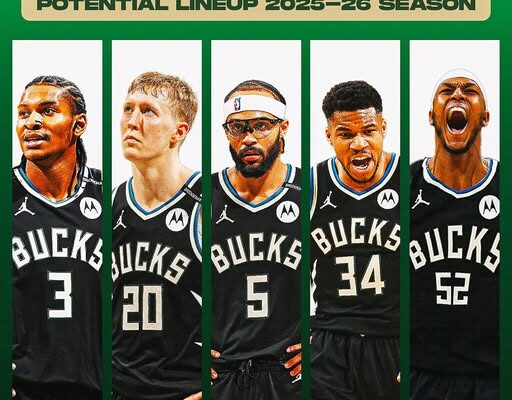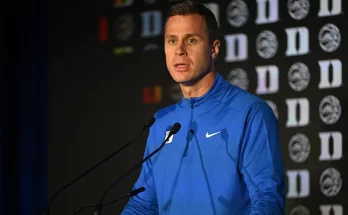The Milwaukee Bucks enter the 2025-26 NBA season at a pivotal crossroads, navigating a period of transition that promises to reshape the identity of the franchise. After a turbulent offseason marked by significant roster changes, the Bucks are faced with the challenge of reloading their lineup to remain competitive in the ever-evolving landscape of the NBA’s Eastern Conference. Central to this transformation is the departure of Damian Lillard, a marquee player who had provided leadership and scoring punch since joining the team, and the strategic acquisitions aimed at fortifying key areas of the roster, most notably the signing of Myles Turner and the re-signing of Gary Trent Jr. These moves signal Milwaukee’s intent to blend a more balanced approach of interior strength and perimeter shooting, hoping to build a team capable of sustained success and a deep playoff run.
The decision to part ways with Damian Lillard was one of the most talked-about developments of the offseason. Lillard, known for his clutch shooting, offensive creativity, and leadership qualities, had been a centerpiece in the Bucks’ lineup. His ability to create shots under pressure and facilitate offense made him an invaluable asset, especially in high-stakes playoff situations. However, the dynamics of the team, salary cap considerations, and the desire to pivot towards a more versatile roster led Milwaukee’s front office to make the tough call to move on from the veteran guard. The departure leaves a void in terms of both production and experience, but it also opens opportunities for the Bucks to redefine their style of play.
Replacing a player of Lillard’s caliber is no small task, and the Bucks’ approach has been one of strategic reinvestment in areas that complement their core strengths. The acquisition of Myles Turner stands out as a cornerstone of this rebuilding phase. Turner, a seasoned big man with a reputation as one of the league’s premier shot blockers, brings a much-needed interior presence to Milwaukee’s frontcourt. His ability to protect the rim and anchor the defense aligns perfectly with the Bucks’ vision of improving their defensive efficiency. Beyond his shot-blocking prowess, Turner’s offensive game is multifaceted. He can stretch the floor with his three-point shooting, operate effectively in pick-and-pop situations, and is skilled at finishing around the basket. This versatility makes him a perfect fit alongside Giannis Antetokounmpo, allowing Milwaukee to space the floor while maintaining a formidable defensive core.
Turner’s impact on the team is expected to be significant not only on the defensive end but also in how the Bucks manage matchups against elite big men in the Eastern Conference. His rim protection will alleviate pressure on Giannis, who often has to cover multiple roles defensively. This should enhance Milwaukee’s overall defensive scheme, making the team more formidable against opponents with dominant interior players. Offensively, Turner’s shooting and passing ability will add another layer of complexity, enabling the Bucks to run more diverse sets and keep defenses guessing. His presence is anticipated to open up opportunities for role players and facilitate smoother ball movement, which has sometimes been inconsistent in previous seasons.
Complementing Turner’s interior presence is the re-signing of Gary Trent Jr., a dynamic perimeter player who provides the Bucks with much-needed scoring and spacing from beyond the arc. Trent, known for his sharpshooting and aggressive scoring mentality, adds a valuable dimension to Milwaukee’s backcourt. His ability to knock down three-pointers at a high clip will be critical in a league that increasingly rewards efficient perimeter shooting. Moreover, Trent’s tenacity on defense and willingness to take on challenging assignments contribute to his overall value on the court. His return to the Bucks signals a commitment to building a more balanced attack, where scoring threats come from multiple areas on the floor.
Trent’s presence is particularly important given the Bucks’ need to replace some of the offensive output lost with Lillard’s departure. While Trent is not a like-for-like substitute for Lillard’s playmaking and leadership, his ability to stretch defenses and score in bunches will help fill the scoring gap. Additionally, his defensive effort and energy align with Milwaukee’s emphasis on toughness and accountability on that end of the floor. With Trent back in the fold, the Bucks can expect a boost in their perimeter shooting percentages and an improvement in spacing, which will in turn benefit Giannis and other offensive weapons by reducing defensive congestion in the paint.
The Bucks’ transition also involves a broader evaluation of their supporting cast and how they can integrate new pieces into the existing framework. The team still boasts a core that includes Giannis Antetokounmpo, one of the most dominant players in the league, whose unique combination of size, athleticism, and skill makes him the centerpiece of Milwaukee’s ambitions. However, surrounding Giannis with the right complementary pieces has always been a balancing act. The front office’s focus in this offseason appears to be on constructing a roster that maximizes Giannis’s strengths while addressing some of the shortcomings seen in previous playoff runs, such as perimeter shooting consistency and defensive versatility.
In addition to Turner and Trent, the Bucks will be looking to younger players and role players to step up and contribute meaningfully. Player development will be crucial as the team seeks to build depth and versatility. This includes fostering growth among emerging talents who can take on larger roles and provide the kind of energy and hustle that Milwaukee has historically valued. The coaching staff’s role in integrating these new pieces and fostering a cohesive team culture will be vital. The challenge will be in finding the right mix of players who buy into the system and can execute the game plan effectively on both ends of the court.
The coaching strategy moving forward will likely emphasize adaptability and a balance between inside-outside play. With Turner anchoring the defense and stretching the floor offensively, the Bucks can employ a more fluid style that leverages Giannis’s ability to attack the rim while giving shooters like Trent the space they need to operate. This balanced approach aims to make Milwaukee less predictable and more difficult to defend, a necessity in a conference filled with rising contenders and perennial powerhouses. Defensive schemes will also be adjusted to maximize Turner’s shot-blocking and rim protection, potentially allowing Giannis to conserve energy for offense by reducing his defensive workload.
The Bucks’ front office has also had to consider the salary cap implications of these moves, ensuring financial flexibility for future seasons. The NBA’s salary cap environment requires teams to be strategic in how they allocate resources, balancing star contracts with supporting role players. By moving on from Lillard and bringing in Turner and re-signing Trent, Milwaukee is managing to maintain a competitive payroll while positioning themselves for sustainable success. This financial prudence is important for maintaining roster flexibility and the ability to pursue further upgrades either through free agency or trades.
While these offseason moves mark a new chapter, the Bucks will need to prove that they can translate their roster changes into on-court success. The Eastern Conference remains highly competitive, with teams like the Boston Celtics, Philadelphia 76ers, and Miami Heat continually evolving and vying for supremacy. The Bucks’ ability to remain a top contender will depend on how quickly the new pieces gel and how well the coaching staff can implement a cohesive system that maximizes the strengths of the revamped roster. Chemistry will be a key factor, as well as health, which has been a concern in previous seasons.
In terms of team identity, Milwaukee’s direction appears to be focused on toughness, versatility, and balance. The combination of a dominant interior presence with Turner, elite perimeter shooting from Trent, and the unmatched athleticism of Giannis provides a blueprint for a well-rounded team. This new roster configuration could make the Bucks a formidable opponent capable of adapting to various styles of play they encounter throughout the season and playoffs. It also signals a potential shift away from relying heavily on a single superstar scorer towards a more team-oriented approach where multiple players contribute consistently.
Moreover, the Bucks will likely look to leverage their experience from past playoff campaigns to mentor younger players and build resilience. Lessons learned from both success and shortcomings in recent years will shape their approach to game preparation, in-game adjustments, and mental toughness. The pressure to perform at a high level remains immense, but the revamped roster and fresh energy provide a sense of optimism and excitement around the franchise’s future.
Off the court, Milwaukee’s fan base remains passionate and loyal, hungry for another championship run. The Bucks’ management will be under scrutiny to deliver results, but the combination of shrewd roster moves and the continued presence of Giannis gives the organization a solid foundation. The city’s enthusiasm and support will be crucial in fostering a positive environment for the players and coaching staff throughout the grind of the regular season and into the playoffs.
In conclusion, the Milwaukee Bucks enter the 2025-26 season with a renewed sense of purpose and a roster that reflects a thoughtful rebuilding effort after a challenging offseason. The departure of Damian Lillard is a significant change, but the acquisition of Myles Turner and the re-signing of Gary Trent Jr. signal a strategic shift towards building a more balanced, versatile team. With Giannis Antetokounmpo still leading the charge, the Bucks aim to leverage their new pieces to improve defensively, enhance perimeter shooting, and foster a cohesive team identity that can contend in a tough Eastern Conference. While challenges remain, the foundation is in place for Milwaukee to once again compete at the highest level and potentially make a deep playoff push. The success of this transition will depend on chemistry, health, and execution, but the Bucks have made clear their commitment to returning to championship contention.



